
- Volume 10 Front Page
- Contents & Foreword
- New Life for an Egan Harp
- Memories of Glenmore House
- The Brontës & Arthur Bell Nicholls
- Jack Sinclair Local Hero
- Lisburn's Historic Quarter
- The Richard Wallace Trust (Lisburn)
- The effects of the Spanish Civil War on Ireland
- Hillsborough House Twelfth Night Ball
- The Blessington Estate And The Downshire Connection
- A Brief History Of Lisburn's Airbases
- Recollections Of The Second World War In Lisburn
- The end of an era - Barbour's Of Hilden
- Summer outings
2000 - 2005 - Recent Book Launches & Meetings
- Book Reviews
- Historical Journals
Lisburn Historical Society
Volume 10 • 2005 - 2006
BOOK REVIEWS
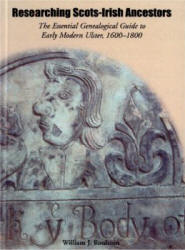 WILLIAM J. ROULSTON, Researching Scots-Irish
Ancestors. The Essential Genealogical Guide to Early Modern Ulster,
1600-1800. (Belfast: Ulster Historical Foundation, 2005. Pp. 262.
£11.99)
WILLIAM J. ROULSTON, Researching Scots-Irish
Ancestors. The Essential Genealogical Guide to Early Modern Ulster,
1600-1800. (Belfast: Ulster Historical Foundation, 2005. Pp. 262.
£11.99)
The author, William Roulston, is a research officer with the Ulster Historical Foundation. He has to his credit numerous publications on the subject of the history of Ulster during the seventeenth and eighteenth centuries. Beyond the general title lies a fascinating book packed with a vast amount of facts and figures in an easy to follow format which absorbs the reader. Many of the intricate details derived from original sources are uncanny should one wish to make comparisons with events of the present day. Undoubtedly, history does repeat itself.
It is fascinating to read that the First Presbyterian Foundation in 1642 was established following the arrival of a regiment of the Scottish Army to protect Scots settlers. At Carrickfergus a congregation was formed despite considerable persecution almost fifty years prior to the arrival of William Prince of Orange.
The emergence of English settlers in large numbers occurred in the mid seventeenth century period — Sir Arthur Chichester, Sir Fulke Conway, Sir John Clotworthy, for example. Scotland was also well represented. The names of two Scots occur — James Hamilton and Hugh Montgomery. By contrast settlers from Wales were introduced in the area surrounding Newry in1610-1611.
Following the establishment of Quakers in Lurgan c.1660, in Lisburn the religious Society of Friends is credited with a Meeting recording minutes in 1675.
References to poll tax occur as early as 1660. Hearth Money Rolls were introduced during 1663 as a form of taxation. A modern derivation of this would be a tax on the number of radiators to be found in any household — perish the thought. Also imagine the protest resulting from a lawful
requirement which necessitated a lessee by obligation to allocate six clays annually to provide road maintenance. Curiously, by 1800 Ulster had one of the densest road networks in Western Europe.
With the arrival of Cromwell in Ireland during 1641 continuity of the existing estate system prevailed. Thus, well known land owners held sway until more recent times; for example, the families of Lord Arthur Hill, Hillsborough, Co Down, Sir George Rawdon, Moira, Co Down, Henry Brooke, Colebrook, Co Fermanagh, come to mind.
By contrast in 1670 the Catholic Archbishop of Armagh noted a population in Armagh City of approximately 3000 persons, almost all were Scottish or English with very few Irish. The Williamite War in Ireland 1688/91 is briefly documented.
In present day discourse the phrase cross-community often occurs. However during the seventeenth century the Presbyterians emerged as a distinct denomination and mostly Scottish whereas the English were virtually all Anglican. Roulston's research shows there were exceptions. For example, Captain John Hamilton, Stranorlar, Co Donegal, was described as a most zealous Catholic — a pious and liberal man and a great apologist for the faith having previously been both a Presbyterian and an Anglican. Ironically he later emigrated to Germany to become a Count in the Holy Roman Empire. This perhaps could be better described as criss-cross community.
The eighteenth century saw the emergence of a thriving linen industry which embraced virtually all of the nine counties. Mills sprang up in locations with a regular supply of fresh water, eventually giving employment to thousands in the various aspects of manufacture. The Lagan Valley proved to be an ideal location for most processes in the manufacture with acres of bleach greens available. In 1700 Ireland exported one million yards of cloth; by 1800 production of linen in Ulster comprised a staggering forty million yards. For many workers, linen was their sole source of income. Digressing briefly from the book, it is interesting to note that buttermilk was the only acid used in the bleaching process.
Both Quakers from England and Huguenots from France were in the forefront of establishing the success of linen manufacture. Lisburn City proudly supports an award winning Linen Centre and Museum. Bessbrook, by contrast, is a surviving `model' village. Alas, the looms there are silent witness to the changing times in stark contrast to the early history.
Harsh treatment was meted out to dissenters, mainly Presbyterians, who were aggrieved by laws which were undoubtedly discriminatory. Marriage ceremonies conducted by a Presbyterian minister were considered unlawful and children born of such a marriage were regarded as illegitimate. There were restrictions concerning public office. The passing of the Penal Laws by the Irish Parliament during the period between 1695-1728 ensured Catholics were restricted in a manner which verged on subjugation. Tucked away in concealed locations Mass Rocks may still be found and testify to this period in history. Other documented evidence exists to support these claims.
The expertise of the author straddles every conceivable possibility as he delves in and out of public records during the seventeenth and eighteenth centuries. The landed gentry, Registry of Deeds, wills and testamentary papers, military and church records, newspapers, genealogical records and other miscellaneous sources help to provide vital facts for each case history.
In conclusion, anyone interested in genealogy in
this period cannot fail in their quest if they follow the guidance
of the author. This publication is undoubtedly designed to whet the
appetite and encourage exploration of the family tree.
![]()
STANLEY BELL
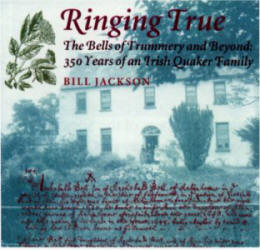 BILL JACKSON, Ringing True. The Bells of Trummery
and Beyond: 350 years of an Irish Quaker Family. (York: William
Sessions Ltd., 2005. Pp. 241. £16.00)
BILL JACKSON, Ringing True. The Bells of Trummery
and Beyond: 350 years of an Irish Quaker Family. (York: William
Sessions Ltd., 2005. Pp. 241. £16.00)
Many years of patient research and acquisition of family lore have resulted in this fascinating record of a family which left Scotland in the mid-1600s and settled in Ulster. Bill Jackson in his preface explains that his original intention was an exercise for the benefit of his children and grandchildren. However, as he proceeded in the task he realized that what he was producing might be of interest to the wider family and the general public.
While we might assume that the history of one particular family is of limited concern, yet the activities they were engaged in and the issues they represented are of enormous interest to all whose forebears have lived in Ulster during the same period. What Bill Jackson presents is not merely a personal family history but a social history over twelve generations with which many of us can readily identify.
Most of us today are not many generations removed from the land and over the centuries many Bells were engaged in farming in the fertile land of the Lagan valley near Moira and elsewhere. The early generations saw the opportunities of trade in tanning, using tannin from the oak forests which were being cleared and the abundant supply of cattle to create a product which was highly prized. They, too, were in the forefront of the linen business in the province and accounts of mills and factories in Belfast, Ballyclare and Lurgan are a reminder to us of our industrial heritage. The author faithfully portrays their innovations, difficulties and disengagement from the industry in changing economic circumstances. Their creative genius is shown in the wide diversity of interests and occupations, eminent among which is that of Jocelyn Bell Burnell, the astrophysicist, whose research on pulsars when a postgraduate student helped to earn for her supervisor, Professor Anthony Hewlish, a Nobel Prize.
Emigration is a feature of life which every family in Ulster has experienced. Bill Jackson traces the Bell diaspora to North America, Australia and, most surprisingly, Cuba. This exotic branch of the family is that of the captain of a merchant ship who settled in Cuba about 1800 and had extensive coffee plantations. He assumed the name Ricardo Maria Bell and married the daughter of his business partner by whom he had ten children. It is reckoned that there are 463 known descendants, but none of the Bell name, as they are all descended from female lines.
Religious belief is an important part of life to the Ulster man or woman. The original immigrant, Archibald Bell, joined the Society of Friends about 1657, almost at the start of the Quaker movement, and, despite the harsh disciplinary rules of that body in early years, a surprisingly large number of his descendants remained loyal to that faith. Whether Quakers or not, they were to the fore in philanthropic causes, such as the Anti-Slavery movement and enterprises for the care of the needy and destitute.
It is well known that Quaker records are a good source for authoritative historical facts and the author draws extensively from these archives. In addition, earlier family historians provide a framework which he has used to good effect and vignettes from other sources of individual Bell characters enliven the narrative. Illustrations of family members, former residences and workplaces, maps and reproductions of memorabilia supplement the text in an attractive way. The book is laid out in chapters according to the century under review and at the end of each a full list is given of the family members. Given the complexity of the exercise and the vast numbers involved, a traditional family tree cannot be provided, but it would have been useful if the different branches of the family had been more easily identified.
For the extensive Bell family this is a wonderful
resource, but for all who live in Ulster it is a valuable record of
men and women who in their own particular way have contributed and
continue to contribute to life in this land and beyond.
![]()
ARTHUR CHAPMAN
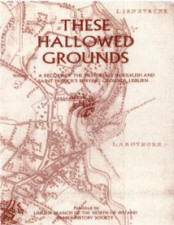 |
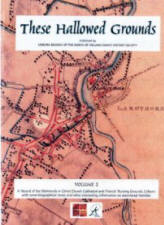 |
LISBURN FAMILY HISTORY SOCIETY, These Hallowed Grounds.
Vol 1: Memorials in Kilrush and Saint Patrick's Burying Grounds (Belfast: Northern Whig Ltd., 2001. Pp.179. £9.50)
Vol 2: Memorials in Christ Church Cathedral and Burying Ground and of Friends' Burying Ground, Railway Street (Belfast: Northern Whig Ltd., 2005. Pp.306. £12.50)
The Lisburn branch of the North of Ireland Family History Society has put us all in its debt with the publication of these two books. In each case, the title does not adequately describe what the reader will find within, as the compilers have gone to considerable lengths to provide the family historian with much more background information than is normally provided in such books. In so doing, they have cast their net far and wide.
As Kilrush is now almost forgotten, in spite of its central position in Lisburn, it is opportune to have this history of the graveyard, probably the oldest still extant in the area, already available. So few headstones are now visible, many fewer than when they were listed by members of the Lisburn Historical Society in 1974, that it is of great historical interest to have this record. The tracing of a Re-Registration listing, dating from perhaps 1888, was a real `find'.
The early background of Saint Patrick's Mass House and Burying Ground is also of interest, with a stone dating it to 1786. Burials commenced around 1840-50 as earlier Roman Catholic burials apparently took place in Kilrush. In addition to the detailed listing of the burials and maps of the graveyard, the compilers have also given us a history of Saint Patrick's Chapel, a familiar landmark on the Lisburn scene, as well as the earlier building which the present church replaced in 1900.
The second volume is considerably larger; although the same basic plan has been adopted, the two burial grounds which have been researched have more accessible records for consultation, Christ Church Cathedral and Friends' Burying Ground in Railway Street. Indeed, the records of the Cathedral, now in the Public Record Office, including the register from 1637-1646, are the earliest extant post-Reformation church records in Ulster. All gravestones in the Cathedral churchyard have been recorded, as also all memorials inside the Cathedral and the more recent Garden of Remembrance. Whilst this information is invaluable, it will still be advisable for the researcher to examine the microfilms in the Public Record Office; in my experience at Drumbo Parish Church, not every gravestone has an entry in the burial register, nor has every burial been entered in the register. The churchyard of the Established Church, in this case the Cathedral, was the `accustomed' burying place for anyone who did not have allegiance to a particular denomination and that churchyard was usually the place of burial. Entry in the Register was the responsibility of the Rector, or other officiating clergyman; this action seems not necessarily to have been carried out immediately, but often on a weekly, or even longer basis. And of course, the erection of a headstone was the responsibility of the family, who, if poor, may not have been able to afford one.
How many people walk down Railway Street without any thought of the Quaker burying ground hidden behind the wall half way down on the left hand side? Here lie the remains of many members of the Society of Friends, who left their mark on the history of Lisburn in no uncertain way over almost 350 years. Here lie the Richardsons, the Hancocks, the Hoggs, the Malcomsons and many others, all names to be conjured up in the early and later burgeoning history of the linen industry, which was the basic industry of Lisnagarvey, later Lisburn, and its surrounding area in its formative years. The Society of Friends has preserved intact all its Registers of Births, Marriages and Deaths, which are of huge interest to the genealogist and of which the compilers of this book have made full use.
So far in this review, I have written of the basic information which any genealogist may expect to find in a church or graveyard. But I have left the real interest until the end. Many hours have been spent in the Public Record Office on the Will Indexes, dating from 1858 until the present day; here can be traced much information of value to the family historian. Addresses, family names and relationships, dates of death and probate and, of great interest in the case of industrialists, the assets which they left. This information has been sought out by the compilers for many former citizens of Lisburn and included in the books. "There are also reprints of newspaper obituaries; very often these
give lists of mourners which are of assistance in placing an individual in his/her social setting.
Over the last two centuries, a small number of families are now remembered as, what we might call, `Prominent Families' in the history of Lisburn. 1 refer to the Barbours, the Richardsons, the Mulhollands, the Coulsons, the Stewarts, the Jeffersons, the Nicholsons, and many more. The real value of this book is the concise histories of these families, of interest to a much wider readership than those seeking their family history. These are the people who made Lisburn what it is today and whose names should not be forgotten. I congratulate the Lisburn branch of the Family History Society on these publications — if you have not got Volume 1, beg or borrow it!
We should also be looking forward to Volume 3;
might I suggest Blaris old graveyard, Magheragall, Broomhedge,
Templecormac and many others?
![]()
FRED RANKIN
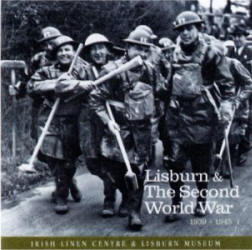 IRISH LINEN CENTRE & LISBURN MUSEUM, Lisburn and
the Second World War 1939-1945. (Lisburn, 2005. Pp.30. Free of
charge)
IRISH LINEN CENTRE & LISBURN MUSEUM, Lisburn and
the Second World War 1939-1945. (Lisburn, 2005. Pp.30. Free of
charge)
On receipt of my copy of the booklet printed to augment the exhibition at the Irish Linen Centre & Lisburn Museum my curiosity was aroused by the front cover presentation prompting the memory bank into serious consideration. Who were they and what were they doing? Certainly they looked a real jolly bunch, demonstrating the spirit of the age and seemed to reflect the courage and defiance which was prevalent throughout the entire nation in the struggle against Germany and the regime led by Adolf Hitler.
Surprisingly, they were suitably clad members of the ARP (Air Raid Precautions), a stalwart group of enthusiastic volunteers sporting their initialed tin hats. A specialised trained section equipped to deal with rescue and casualty. Serious business lay ahead in the event of an air attack by the German Air Force. The threat of gas bombs was considered a real possibility. These men and women were trained to deal with risks attached to contaminated food in addition to anti-gas precautions, Apparently Lisburn was in the forefront of local authorities in having introduced air raid wardens and other voluntary requirements to deal with civilian casualties.
Events leading up to the outbreak of war are well documented. Following commencement of hostilities the local economy took a massive upturn. Lisburn, situated in the heart of the Lagan Valley, employed numerous workers in the manufacture of a wide range of products from bootlaces to uniforms, tents for the armed forces and all types of thread that were necessary in the process. Large quantities of linen were required and produced in the mills centred in convenient locations in and around the town.
Once again the local economy was booming. Concentration of RAF facilities at Aldergrove, Langford Lodge, Nutts Corner and Long Kesh projected Lisburn into the front line of defence and an obvious target second only to Belfast with its shipyard and aircraft factories in full production. Despite the fact that Northern Ireland was exempt from conscription the booklet informs us that the armed forces recruited 38,000 men and women from the province. Units of the British Army, Royal Navy and Royal Air Force were stationed in addition to American and other allied Forces.
For many people on the home front rationing was a way of life and utility was a word which was part of everyday language. Clothing, furniture and certain food commodities required ration books. On buses and trams slatted wooden seats replaced the more comfortable seating thus releasing more raw materials for the war effort.
The format of the booklet is precise, displaying various subtitles, seven in total, set in a distinctive coloured broad band, highlighted by large white lettering. Each of these sections conveys a different aspect of the war effort. They are very informative and break down into various categories relevant to the events of the time. The entire work is compacted into a pleasing publication which is illustrated with no fewer than seventy photographic and other images, ration books, identity cards, etc. A complete collection of badges, including many examples of the voluntary organisations involved in the war effort, is included.
An exhibition mounted by the Museum staff in June 2005 which runs until June 2006, displays lots of artefacts and memorabilia depicting the period of the war very graphically. A short film in the comfort of the mini-cinema provided a nostalgic trip down memory lane, a revelation for young and old alike.
In conclusion the combined effort has been very informative having brought to life in vivid detail the history surrounding the period of the Second World War and the contribution made by Lisburn in the war effort.
STANLEY BELL
